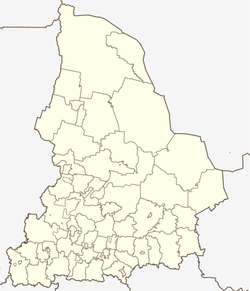Irbit
| city
Irbit
Ирбит
|
||||||||||||||||||||||||||||||||||||||||
|
||||||||||||||||||||||||||||||||||||||||
|
||||||||||||||||||||||||||||||||||||||||
| List of cities in Russia | ||||||||||||||||||||||||||||||||||||||||
Irbit ( Russian Ирбит ) is a city in Sverdlovsk Oblast ( Russia ) with 38,357 inhabitants (as of October 14, 2010).
geography
Irbit is the administrative center of the former Rajon in the southeast of the Sverdlovsk Oblast and is located on the eponymous river Irbit at its confluence with the Niza , about 200 km northeast of the regional capital Yekaterinburg . The closest city is Turinsk 55 kilometers northeast.
history
Irbit was founded in 1631 under the name Irbeiskaja sloboda (Ирбейская слобода), in 1662 it was renamed Irbit . The first settlers here mainly traded and organized annual fairs, which was offered because of the favorable traffic situation. In 1643 the Irbiter fair was given the official status of a trading center and gained national importance in the 17th and 18th centuries.
In 1773 the rebel troops around Jemeljan Pugachev tried to take Irbit, but failed due to massive resistance from local merchants. As a reward for this, Tsarina Catherine II “the great” named Irbit two years later and granted money for representative buildings, including a cathedral (which was destroyed in the 1930s).
In the 18th and 19th centuries, the Irbiter Fair was one of the largest marketplaces in Siberia and the Ural region. Among other things, tea from Siberia and China was traded here. However, this development ended at the beginning of the 20th century when the Trans-Siberian Railway was laid, which bypassed Irbit.
In the 1930s, several important large companies were built in Irbit, so that the city became an industrial center. From 1941 to 1945 some factories evacuated from the European territory of the Soviet Union because of the Second World War were added.
Population development
| year | Residents |
|---|---|
| 1897 | 20,062 |
| 1926 | 11,700 |
| 1939 | 25,832 |
| 1959 | 45.275 |
| 1970 | 49,289 |
| 1979 | 51,329 |
| 1989 | 51,708 |
| 2002 | 43,318 |
| 2010 | 38,357 |
Note: census data (1926 rounded)
economy
Internationally, Irbit is primarily known as the location of the Irbiter Motorradwerke , which sells its products under the trade name Ural . In addition, Irbit has another noteworthy factory that produces special glass. The city's other industrial operations include a pharmaceutical plant as well as food production and wood processing companies.
Attractions
Irbit has parts of the historic old town with merchant buildings from the early 19th century around the former fairground. There are also several museums in Irbit, including a local history museum, a history and ethnography museum, a fine arts museum and the only motorcycle museum in Russia.
sons and daughters of the town
- Yuri Litujew (1925–2000), athlete
- Olga Tschernjawskaja (* 1963), discus thrower
Individual evidence
- ↑ a b Itogi Vserossijskoj perepisi naselenija 2010 goda. Tom 1. Čislennostʹ i razmeščenie naselenija (Results of the All-Russian Census 2010. Volume 1. Number and distribution of the population). Tables 5 , pp. 12-209; 11 , pp. 312–979 (download from the website of the Federal Service for State Statistics of the Russian Federation)




